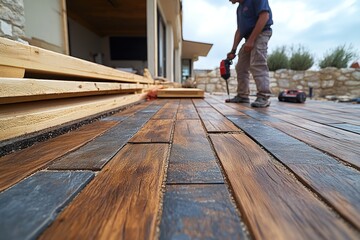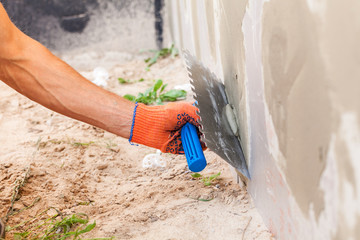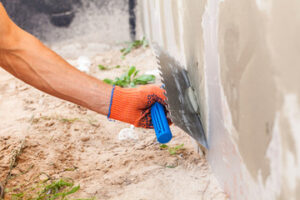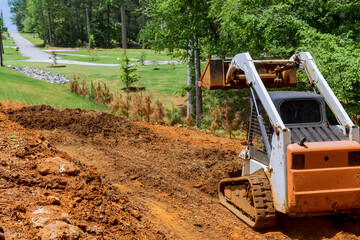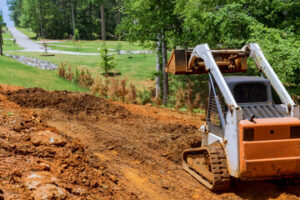Deck building is a complicated endeavor with many different ways to go about it. This article will lay out some established best practices to get you started.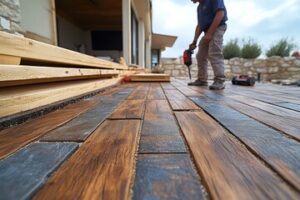
Begin by measuring and marking the area where your deck will be constructed. Make sure the space is level and below the winter frost line. Contact Deck Builders Baltimore for professional help.
Decking and railing make up the visible portions of a deck, but they aren’t the only materials needed. For starters, you’ll need framing, which is usually built using pressure-treated wood—but this doesn’t necessarily have to be the case if you choose more durable and environmentally friendly materials.
For example, aluminum is carving a niche in the industry as a material that offers resilience and longevity. It’s also lightweight, a trait that can save on construction costs by decreasing the amount of lumber needed to build a deck. And since it can be molded into different shapes and sizes, it can align with contemporary design trends—making it a popular choice for forward-thinking architects.
Traditional wood remains a classic choice for many homeowners. It’s available in a wide range of colors, and it’s naturally resistant to rot and insects. However, wood can warp and crack over time, requiring frequent maintenance like staining. As the need for low-maintenance materials grows, so does interest in alternative options.
Composites, which are made from recycled wood fibers and plastics, offer durability and beauty without requiring much in the way of care. Some even come with a warranty against fading, staining and insect damage. However, the initial cost can be high, and entry-level composites aren’t as strong as their more expensive counterparts.
Wood that has been thermally modified is another option that’s growing in popularity. The process alters the structure of the wood, making it more resistant to moisture and decay. This reduces the need for chemical treatments, aligning with modern concerns for environmental sustainability.
If you want a more natural, exotic look, consider tropical hardwoods such as tigerwood and ipe. These dense and hardy species are mildew- and termite-resistant, and they offer rich colors that can complement any home. They’re also more durable than traditional woods, but they can be difficult to work with, which drives up labor costs.
Winter-resistant materials are essential for a deck that will endure freezing temperatures, snow and ice. The right materials will help prevent warping, splintering and other damage caused by harsh weather conditions.
Layout
A deck layout is a set of plans that shows how a deck will be constructed and how it will fit with existing structures. It includes the necessary materials and a design that meets local building standards. The plan may also include a list of tools and written directions for the construction process. It can help the DIY deck builder or contractor avoid costly mistakes during construction and ensure that all the components of the deck are properly anchored to the ground for safety and stability.
The deck frame includes a ledger board, footings and posts, and support beams. It is most often built with pressure-treated lumber. The structure is anchored to the ground using concrete or poured footings. The posts, which are the center of the deck frame, may be wood or steel. Deck posts are often capped with decorative caps or balusters. A deck can have a straight or angled layout, and it can be a rectangular or octagonal shape. An octagonal deck is an excellent choice for large backyards and can serve as a focal point in the yard.
Deck rails are typically composed of a top and bottom rail and handrails. The height of a rail depends on local building codes, and the handrails should be able to accommodate the weight of a person. Deck rails can be constructed of a variety of materials, including metal, vinyl, and synthetic wood.
The stairway and railings are usually installed prior to laying the surface decking. This helps to protect the boards from rain, snow, and other weather conditions that might damage or stain them. It is important to use a strong, sturdy material for the stairway and railings, especially when building an elevated deck.
Joist blocking, or bridging, consists of blocks that are installed between the joists of a deck. It reduces the deflection of a joist that is under load and makes it feel more stiff and stable. It is also a cost-effective alternative to joist hangers or joist ties, which are fasteners used to secure joists to a ledger board, wall, or rim board.
Posts
Your deck’s posts will transfer its weight and live load to the footings below, so they need to be sturdy. The size of the post depends on how much it needs to support. The most common sizes are 4×4 and 6×6. Larger posts are used to anchor stair stringers and heavy objects like hot tubs. The posts also connect to horizontal beams and joists that hold the rest of the deck frame.
Deck builders typically dig post holes to the appropriate depth and set them with concrete, although some prefer to use precast post anchors that save time and labor. Either way, the post footers should be set below the frost line to prevent the ground from pushing up the posts (known as heaving) during winter. To ensure a solid foundation for your deck, you should also use a pressure-treated wood product rated for ground contact.
Once the posts are in place, you can start building the deck. Use a level to check the plumb of each post and, if necessary, install temporary braces. For best results, mark your deck post locations before digging. You should also use a string level or other line to establish a straight, square corner in your deck outline. To help you keep your lines straight, tie mason’s twine or other string between stakes placed at each corner of the deck area.
The deck posts need to be properly connected to the horizontal deck beams and joists using the proper hardware, such as joist hangers. This helps maintain the integrity of the deck and extends its life. Always use weather-resistant hardware, as the chemicals in treated wood can be corrosive to metal fasteners.
Posts that attach to joists often need to be notched to accommodate the joist’s maximum “span.” This figure, which is determined by the type of wood used for the joist and its structural capacity, should be indicated on the joists themselves. During installation, you should reference the maximum span chart to help you determine where to position the deck posts for the best strength and stability.
Railing
Once the footings and posts are in place, the frame for your deck is starting to take shape. This part of the project may take a while, depending on the size and scope of your deck and the complexity of its design. Once the joists are attached, it’s time to add stairways and railings. Building these components isn’t just for aesthetics; most decks are required by local building codes to have a system of stairways and railings for safety reasons.
Stairways and railings can be constructed from a variety of materials, including wood, metal and vinyl. Often, a mix of these is used to create a unique and decorative style that also provides a level of safety for the people using the deck. If you’re building a deck that will be elevated above your home, it’s important to check with the local building inspection office to make sure the railing height and spacing comply with code requirements.
To build a deck, you will need a lot of lumber, including 6 x 6 posts, 2 x 10 or 2 x 12 beams for the joists and supports, and 1 x 4 or 1 x 6 boards for the surface decking. It’s a good idea to use pressure-treated lumber, which is treated with chemicals that will protect it against insects and fungi. You will also need a variety of fasteners and metal connectors, all of which should be made with corrosion-resistant materials.
A deck can be a wonderful outdoor living space that lets you enjoy the natural surroundings from the comfort of your own home. The benefits of a deck go beyond just having another area to sit and relax. A well-designed and maintained deck can increase the value of your home.
Deck building is a full-fledged construction project that requires special tools. The process involves planning, preparing the site, framing the deck and adding stairs and rails. If you’re new to this type of project, it is a good idea to hire a professional to handle the job for you. This will ensure that the project is completed on time and within budget.
